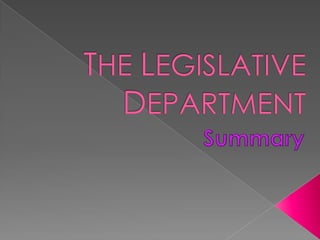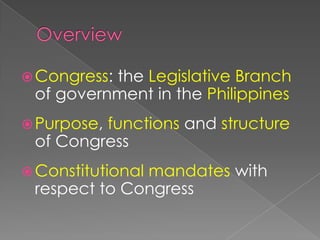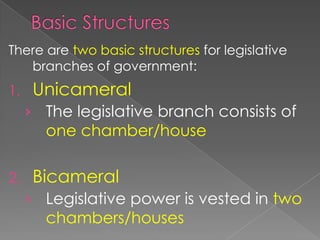The legislative department
- 2. OverviewCongress: the Legislative Branch of government in the PhilippinesPurpose, functions and structure of CongressConstitutional mandates with respect to Congress
- 3. The Legislative BranchFrom the Latin lex, legismeaning lawThe legislative branch broadly deals with the making, deliberation over, enactment, amendment and repealing of laws
- 4. Basic StructuresThere are two basic structures for legislative branches of government:UnicameralThe legislative branch consists of one chamber/houseBicameralLegislative power is vested in two chambers/houses
- 5. The Philippine Congress The Philippine Congress is the country’s legislative department (Art. VI, Sec. 1)Congress is bicameralUpper House: SenateLower House: House of Representatives
- 6. SenateCompositionQualificationsTerm of Office24 Senators elected at largeNatural-born citizenAt least 35 years old on election dayLiterate (can read and write)Registered voterPhilippine resident for 2 years prior to election day6 years Maximum: 2 terms
- 7. House of Representatives200 district reps, 50 party listNatural-born citizenAt least 25 years old on election dayLiterate (can read and write)Registered voter of the districtDistrict resident for 1 year prior to election day3 years Maximum: 3 termsCompositionQualificationsTerm of Office
- 8. In Case of Vacancy…Vacancy can be filled through regular electionSpecial elections can be called for the purpose of filling the vacancyIn either circumstance, the one elected merely sits for the unexpired term
- 9. Parliamentary Privileges Congressmen have two parliamentary privileges while Congress is in session:Privilege from arrestImmunity from offenses punishable by not more than six years imprisonmentPrivilege of speech and debateImmunity from libel and slander
- 10. TransparencyElected Congressmen must:Fully disclose their financial and business interestsDisclose potential conflicts of interests that arise in the course of legislationKeep from any other office or employment (appointed or otherwise), forfeit his/her seat to do so
- 11. Structure and DynamicsSenate President and House Speaker elected by majority voteOther officers, procedures and the discipline of its members is at the discretion of each houseQuorum: MajorityEach House maintains a journal and record of proceedingsNeither House can adjourn without the other’s consent while in session
- 12. Powers of CongressAppointment of Public OfficialsLegislative inquiry and investigationDeclare the existence of a state of warRatify the country’s international treaties (Senate)Authorize limited emergency powers for the President
- 13. Powers of CongressApprove the government budgetUndertake projects under the CDFPropose, review, and adopt bills for enactment into lawOverturn a Presidential veto with respect to proposed legislationAllow for referendaPropose amendments to the constitution and call for a constitutional convention
- 14. Legislative LimitationsCongress may not:Increase appropriations recommended by the executive branchPass tax exemptions without the concurrence of a majority of its membersGrant titles of nobilityPass ex post facto billsPass bills of attainder
- 15. How a Bill Becomes LawReferral to CommitteeDebate1st Reading2nd Reading3rd Reading~House of Representatives~
- 16. How a Bill Becomes LawReferral to CommitteeDebate1st Reading2nd Reading3rd Reading~Senate~1st Reading2nd Reading3rd Reading~House of Representatives~
- 17. How a Bill Becomes Law1st Reading2nd Reading3rd Reading~Senate~BICAMERAL COMMITTEE1st Reading2nd Reading3rd Reading~House of Representatives~
- 18. How a Bill Becomes LawPresident1st Reading2nd Reading3rd Reading~Senate~1st Reading2nd Reading3rd Reading~House of Representatives~
- 19. How a Bill Becomes LawPresidentAPPROVEVETO30 DAY PERIOD1st Reading2nd Reading3rd Reading1st Reading2nd Reading3rd Reading~House of Representatives~
- 20. -end-




















